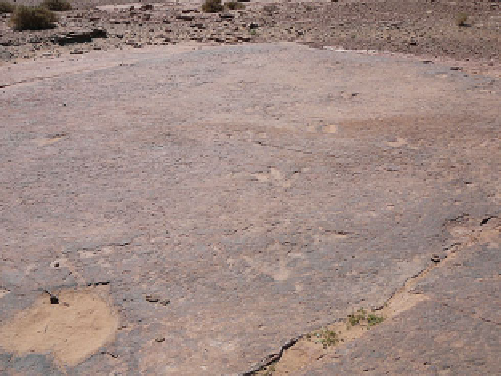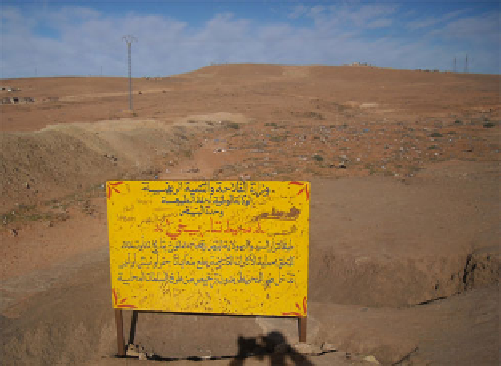Geology Reference
In-Depth Information
Fig. 17
Informative panel near the El Bayadh track site 1
Fig. 16
Theropod trackway at El Mezioued track site
contains large footprints that exhibit 2 trackways and 4 small
isolated footprints.
authorities implement serious protective measures to pre-
serve these footprint sites, especially those located south of
El Bayadh, knowing that many of them are among the
largest dinosaur footprints in the world. As in many coun-
tries in the World, these sites should be considered a global
geoheritage site and declared as a natural monument (Santos
et al.
2008
).
Furthermore, El Bayadh area is a good candidate for a
geopark designation. Indeed, in addition to the hundreds of
dinosaur footprints, the region has a large number of fossil
dinosaurs, hundreds of prehistoric rupestrian carvings, Tri-
assic diapirs, hot springs, extraordinary geological cross-
sections and geological structures of the Saharan Atlas, an
exceptional outcrop of the
3.4.4 El Kohol Daiet Sidi el Arbi Footprints Site
El Kohol Daiet Sidi el Arbi track site is situated south of El
Bayadh at the top of the sandstones of the Continental In-
tercalaire. The tracks are located on a bedding surface of
50 m
2
, and comprise oval-shaped and tridactyl footprints
(Mammeri et al.
2009
). The oval-shaped footprints of
sauropod dinosaurs are very large, with an average length of
120 cm and a width of 110 cm; those that are best preserved
show claw impressions. These footprints are among the
largest in the world. The tridactyl tracks are also large, 60 cm
long and 52 cm wide in average, and show separate digits
with claws. They are assigned to large theropod dinosaurs.
near the
locality of Brezina, caves, and beautiful sandstone buttes.
The creation of a geopark can also enhance the local econ-
omy and tourism in this region, which is among the less-
developed and poorest regions in Algeria.
The other sites reported in this paper, Amoura, Tiout and
Djurdjura, have never been the subject of protective mea-
sures. At Amoura, the tracks have been weathered, and
damaged due to human activity. Several tracks have been
erased and some limestone slabs containing footprints have
been removed (Fig.
18
). From the 140 footprints identi
“
South Atlasic Fault
”
4
Discussion
Although the existence of dinosaur footprint sites in Algeria
has been known for a long time (the Amoura site is one of
the oldest known in the world), because of the rarity of these
sites and the lack of interest shown in them by the scienti
c
community, these sites largely have been abandoned. The
discovery of new track sites over the past ten years in the
region of El Bayadh, and the media coverage given to these
ed
by Bellair and Lapparent (
1948
), only about 50 still exist.
Protective measures must be taken as soon as possible to
protect and to conserve what remains. Amoura site is among
the best candidates for designation as a geosite. Indeed, in
addition to the dinosaur footprints that are among the oldest
known scienti
ndings has revived the study of dinosaur footprints in
Algeria and raised awareness of the need for their protection.
After this later discovery, the local authorities issued a
decree for the protection of these sites (Mahboubi et al.
2007
). An information panel was erected near site 1 indi-
cating that the site is protected against any act of vandalism
(Fig.
17
). Since then, no other protective measures have been
taken and the site has been damaged at several locations. Site
2,
c references to dinosaur tracks in the world
we have already reported that this site has an excellent
Cretaceous cross-section which can act as a study site for
scientists and students. Amoura is also located near the
“
which separates the two major geo-
logical and structural domains of Algeria, i.e. the stable
Saharan domain to the south, and the Alpine/Atlas folded
South Atlasic Fault
”
located north of El Bayadh,
is missing following the
oods that occurred in autumn 2011. It is necessary that the




